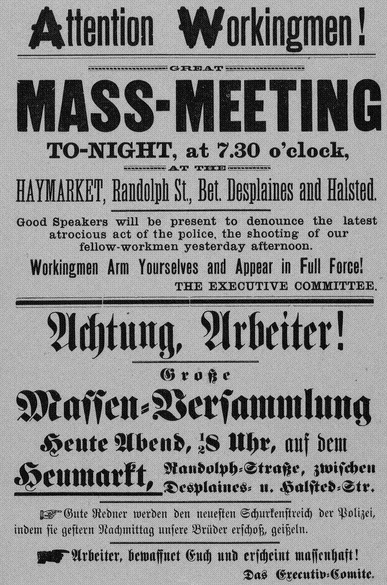May 1
In the mid-1800s May 1 was the de facto date for labor groups to re-negotiate rates with employers, precisely because May 1 marked the beginning of the summer. Workers were in greater demand in summer than in the winter months, which gave them more bargaining power. Also, the traditional holiday May Day was one of the few days workers had off that wasn’t spent at church.
As societies became more industrialized, May Day workers’ gatherings increased in number and intensity.
The first of two major Chicago strikes occurred on May 1, 1867. Labor unions in Chicago had been able to get an ‘eight-hour day’ bill passed in the Illinois state legislature, but couldn’t get it enforced. They declared a strike on May 1; the strike collapsed within a week.
In 1884, the newly formed Federation of Organized Trades and Labor Unions (later the AFL) declared that an 8-hour workday would take effect on May 1, 1886, with or without government legislation. The implication being that any district where this law was not implemented would be effectively shut down.
On May Day, 1886, over a quarter million workers walked off the job across the United States—40,000 in Chicago alone. Over the next few days the Chicago numbers rose to 100,000.
On May 3, police shot and killed two strikers when a scuffle broke out at the McCormick Reaper Works between strikers and “scabs” coming to replace them.
Anarchists organized a rally the following day. Relations were already tense between the police and the strikers, and flyers asked workers to “arm yourselves and appear in full force.”

Miraculously the Haymarket rally was peaceful right up until the end. The mayor had even gone home from the rally, sensing no danger from the dwindling crowd.
At 10:30 in the evening the last speaker finished his speech to a crowd of about 300. Suddenly, as the police moved in to disperse the demonstrators, a homemade bomb was hurled into a throng of officers. The blast and the ensuing violence killed 7 officers and wounded another 60. Police fired into the crowd after the blast, killing an unknown number of demonstrators.
The Haymarket tragedy resulted in the execution of 4 anarchist leaders and a wide-spread government crackdown on not only extremists, but on unions and the labor movement in general. The government’s reaction to Haymarket became a rallying point for unions and socialist organizations in Europe and Asia as well as North America.
The first international labor strike for the eight-hour day occurred on May 1, 1890 partly in tribute to the Haymarket tragedy. As mentioned before, outside the U.S., May Day is called Labour Day or International Workers’ Day.
May Day violence continues to this day. A peaceful immigration demonstration in Los Angeles on May 1, 2007, ended with police firing rubber bullets at demonstrators. (News footage of the event resulted in the retraining of the LAPD to handle crowd control events through the extraction of individual agitators instead.)
In 2008, all ports on the West Coast came to a halt on May Day when the International Longshoremen and Warehouse Union went on strike to protest the war in Iraq. Demonstrations in Germany and Turkey ended in unexpected violence.

2 Replies to “Labour Day”